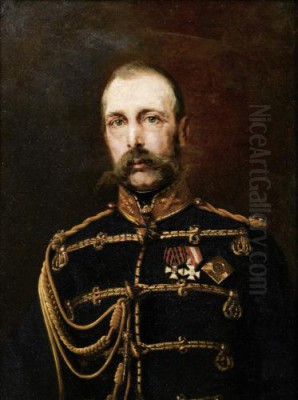
Konstantin Egorovich Makovsky stands as one of the most prominent and commercially successful Russian painters of the latter half of the 19th century. Born into an era of significant artistic and social change within the Russian Empire, Makovsky navigated the currents of Academicism, Realism, and burgeoning national identity to forge a unique and highly popular style. Primarily known for his large-scale historical canvases depicting an idealized Russian past and his flattering portraits of the aristocracy and wealthy elite, Makovsky achieved immense fame both within Russia and internationally. While associated with the influential Peredvizhniki (Wanderers) movement in his early career, his path diverged towards a more decorative, Salon-oriented aesthetic that brought him fortune but also critical scrutiny. This exploration delves into the life, work, artistic evolution, and complex legacy of this fascinating figure in Russian art history.
An Artistic Heritage: Early Life and Education
Konstantin Makovsky was born in Moscow on June 20 (Old Style) / July 2 (New Style), 1839, into a family deeply immersed in the arts. His father, Yegor Ivanovich Makovsky, was an accountant by profession but also an amateur painter, an avid art collector, and one of the founders of the Moscow School of Painting, Sculpture, and Architecture (established in 1843). His mother, Lubov Kornilievna (née Mollengauer), was a composer and singer, adding a musical dimension to the household's creative atmosphere. This environment proved fertile ground for Konstantin and his siblings, several of whom also became notable artists: Vladimir (a prominent genre painter and Peredvizhnik), Nikolay (also a painter), and Alexandra (a landscape painter).
From a young age, Konstantin displayed artistic talent. He received his initial training at the Moscow School of Painting, Sculpture, and Architecture, where his father's influence was significant. He studied under masters like Mikhail Scotti and Sergey Zaryanko, absorbing the foundational principles of academic drawing and composition. The school fostered a connection to Russian life and traditions, perhaps planting the seeds for his later historical interests. His early works already showed promise, demonstrating technical proficiency and a keen eye for detail.
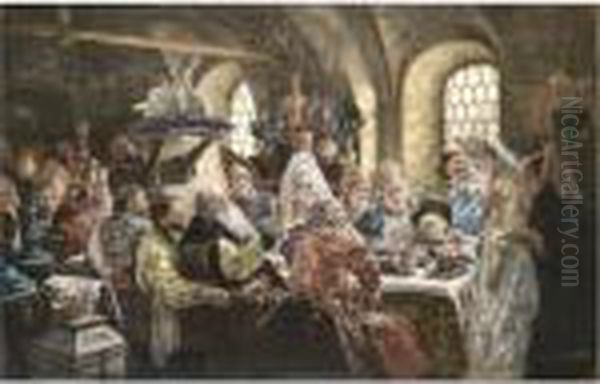
In 1858, seeking to further his education at the highest level available in Russia, Makovsky entered the prestigious Imperial Academy of Arts in St. Petersburg. The Academy, at that time, was still heavily dominated by Neoclassical principles, emphasizing historical, mythological, and biblical subjects executed with a smooth finish and idealized forms. The legacy of Karl Bryullov, whose monumental The Last Day of Pompeii had captivated Russia decades earlier, still lingered, representing a model of academic success and dramatic historical painting that likely influenced the young Makovsky.
The Academy and Early Discontent
During his time at the Academy, Makovsky achieved considerable success, winning medals for his work, including a minor gold medal for Agents of the False Dmitry kill the son of Boris Godunov (1862). This painting demonstrated his early interest in dramatic moments from Russian history, a theme he would return to throughout his career. However, the rigid constraints and thematic limitations imposed by the Academy were becoming increasingly stifling for a generation of artists seeking greater realism and relevance to contemporary Russian life.
A spirit of rebellion was brewing. While Makovsky was not directly part of the famous "Revolt of the Fourteen" in 1863 – where thirteen students and Ivan Kramskoi refused to paint the required mythological subject (The Feast of the Gods in Valhalla) for the major gold medal competition and subsequently left the Academy to form their own cooperative (the Artel of Artists) – he shared their dissatisfaction. According to some accounts, Makovsky himself had earlier faced conflict over thematic requirements, reportedly refusing to paint a subject from Norse mythology, which may have contributed to him leaving the Academy in 1863 without the coveted major gold medal and the associated travel fellowship. This departure marked a significant step away from the established academic path.
The Society for Travelling Art Exhibitions: The Peredvizhniki
The discontent simmering within the Academy and the Artel of Artists eventually coalesced into a more organized and influential movement: The Society for Travelling Art Exhibitions (Tovarishchestvo peredvizhnykh khudozhestvennykh vystavok), commonly known as the Peredvizhniki or Wanderers. Founded officially in 1870, with Ivan Kramskoi as a leading ideologue, the Peredvizhniki aimed to break free from the Academy's control, bring art directly to the provinces through travelling exhibitions, and focus on depicting the realities of Russian life, history, and landscape with truthfulness and often a critical social conscience.
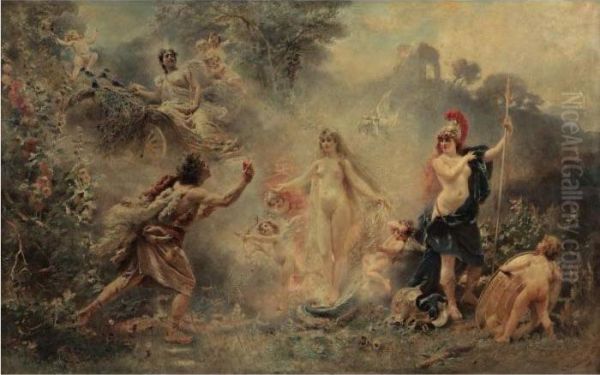
Konstantin Makovsky was one of the founding members of the Peredvizhniki. In the early years of the society, his work aligned with some of its core tenets. He produced genre scenes that touched upon contemporary life, such as Visiting the Poor (1865) and works depicting peasant life or folk customs. His participation in the early Wanderers' exhibitions placed him alongside key figures who would define Russian Realism, including the aforementioned Kramskoi, the master of poignant social commentary Vasily Perov, the lyrical landscape painter Alexei Savrasov, and the epic forest painter Ivan Shishkin.
However, Makovsky's temperament and artistic inclinations soon began to diverge from the more austere or overtly critical realism favored by some of his Peredvizhniki colleagues. While painters like Perov focused on the hardships and injustices of Russian society, Makovsky was increasingly drawn towards the aesthetic, the decorative, and the historically picturesque. His association with the Wanderers became less central to his artistic identity as his career progressed, although he continued to exhibit with them periodically.
A Turn Towards Splendor: History Painting and Salon Success
The 1870s marked a significant shift in Makovsky's artistic direction. His travels abroad played a crucial role in this evolution. A trip to Egypt and Serbia in the mid-1870s exposed him to new landscapes, cultures, vibrant colors, and exotic textures. This experience seemed to awaken a greater interest in surface effects, rich palettes, and decorative potential, moving him further away from the often somber tones of critical realism. His style became brighter, more colorful, and increasingly focused on capturing the visual richness of the world.
This period saw Makovsky turn decisively towards large-scale historical paintings, particularly those depicting the life of the Russian Boyars in the 16th and 17th centuries, before the Westernizing reforms of Peter the Great. These works presented an idealized, romanticized vision of Old Muscovy, emphasizing its perceived exoticism, traditional rituals, and opulent material culture. He became fascinated with collecting antiques – costumes, furniture, textiles, and household objects – which he meticulously incorporated into his paintings, lending them an air of authenticity, albeit a highly curated and beautified one.
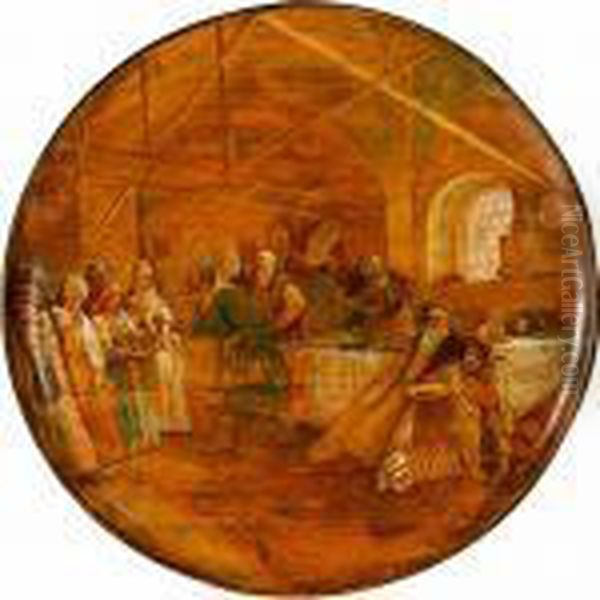
His breakthrough work in this genre, and arguably his most famous painting, was A Boyar Wedding Feast (1883). This enormous canvas depicts a lavish celebration following a traditional wedding ceremony, filled with richly dressed figures, intricate details of food and tableware, and a vibrant, almost theatrical atmosphere. The painting was a sensation. It perfectly captured the public's fascination with the national past while offering a feast for the eyes with its dazzling color and detail. It exemplified the "Salon" aspect of Makovsky's art – accessible, visually stunning, historically evocative, and appealing to the tastes of the wealthy bourgeoisie and aristocracy who were his primary patrons. Unlike the challenging social critiques of Perov or the profound psychological dramas of Nikolai Ge, Makovsky offered historical pageantry and aesthetic delight.
The Celebrated Portraitist
Alongside his historical canvases, Konstantin Makovsky built a phenomenal reputation as a portrait painter. He became one of the most sought-after and highly paid portraitists in Russia, rivaling his European counterparts in fame and fees. His clientele included members of the Imperial family, high aristocracy, wealthy industrialists, and prominent figures in the arts. His St. Petersburg studio became a fashionable gathering place for the city's elite.
Makovsky possessed a remarkable talent for capturing not only a sitter's likeness but also their social standing and personality, often presented in a flattering light. He excelled at rendering the luxurious textures of fabrics – the shimmer of silk, the deep pile of velvet, the softness of fur – as well as the sparkle of jewels and the intricate details of opulent interiors. His portraits are often characterized by their elegance, vibrant color, and a certain idealized beauty, particularly in his depictions of women. His second wife, Yulia Pavlovna Letkova, a beautiful and accomplished woman, frequently served as his model and muse, appearing in numerous portraits and historical compositions.
While Ivan Kramskoi's portraits often delved into the sitter's psychology with penetrating insight, and Ilya Repin captured character with dynamic energy, Makovsky's portraits emphasized elegance, status, and visual richness. They were declarations of wealth and taste as much as records of individual likeness. Works like Portrait of Countess Sophia Stroganova or his numerous depictions of Yulia showcase his mastery of the genre and explain his immense popularity among the upper echelons of Russian society.
Epic Canvases: Reimagining Russia's Past
Makovsky continued to produce ambitious historical paintings throughout his career, solidifying his fame and fortune. These works often focused on dramatic or ceremonial moments from Russian history, rendered with his characteristic attention to detail, vibrant color, and theatrical composition.
A Boyar Wedding Feast (1883): As mentioned, this remains a quintessential Makovsky work. Its success lay in its combination of ethnographic interest (depicting old customs like the bride kissing all the male guests), visual opulence, and a generally celebratory, uncritical tone. It offered a nostalgic glimpse into a lost world of Russian tradition.
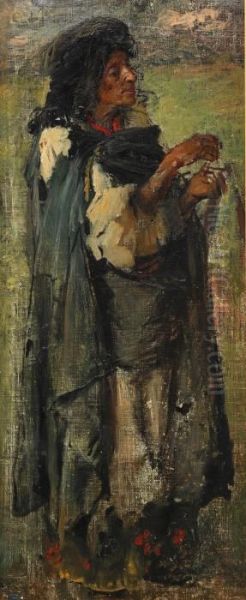
Choosing the Bride (also known as The Russian Bride's Attire) (c. 1889): This painting depicts the ancient custom where the Tsar would choose his bride from a gathering of eligible noblewomen. It allowed Makovsky to indulge his love for depicting beautiful women, elaborate traditional costumes (like the kokoshnik headdresses), and rich interiors. The focus is on the spectacle and the idealized beauty of the scene.
The Death of Ivan the Terrible (1888): Tackling a more somber and dramatic historical event, this painting shows the Tsar moments after he has struck his son, Ivan Ivanovich (though historical accounts vary). While depicting a tragic moment, Makovsky still imbues the scene with rich detail in the setting and costumes, focusing on the emotional drama within a visually splendid context.
Minin Appealing to Prince Pozharsky (1896): This monumental canvas depicts Kuzma Minin, a Nizhny Novgorod merchant, urging Prince Dmitry Pozharsky to lead the volunteer army against the Polish invaders during the Time of Troubles (early 17th century). A highly patriotic theme, the painting celebrates national unity and heroism. Its scale and subject matter were designed to impress and resonate with national sentiment.
Compared to his contemporary Vasily Surikov, whose historical paintings like The Morning of the Streltsy Execution or Boyarynya Morozova conveyed a sense of profound historical tragedy and the psychological weight of events on the masses, Makovsky's historical works generally offered a more romanticized, less psychologically complex, and more visually decorative interpretation of the past. Similarly, Viktor Vasnetsov, another contemporary famous for historical themes, focused more specifically on Russian folklore, epic poems (byliny), and fairy tales, creating a distinct realm of national myth.
Global Acclaim and American Fascination
Makovsky's fame was not confined to Russia. He actively sought international recognition and achieved significant success abroad. The pinnacle of this came at the 1889 Exposition Universelle (World's Fair) in Paris, where he was awarded the Grand Gold Medal for a collection of his works, including The Death of Ivan the Terrible, The Judgment of Paris, and Demon and Tamara (based on Lermontov's poem). This award cemented his status as a major European artist of his time.
His work became particularly popular in the United States during the late 19th and early 20th centuries. American collectors, drawn to the perceived exoticism, technical brilliance, and sheer decorative impact of his paintings, paid enormous sums for his canvases. A Boyar Wedding Feast, for instance, was purchased by the American jeweler Charles William Schuveldt for a staggering 60,000 rubles. Makovsky received numerous commissions from wealthy Americans for portraits and other works, further enhancing his international reputation and considerable fortune. While claims of a direct commission from President Theodore Roosevelt are difficult to substantiate firmly, his popularity and commissions among America's Gilded Age elite are well-documented.
Style, Technique, and Artistic Identity
Konstantin Makovsky's artistic style is a fascinating blend of different influences and tendencies. He retained a strong foundation in academic drawing and composition throughout his career, evident in the careful structure and polished finish of many of his works. However, he infused this academic base with a Romantic sensibility, seen in his choice of dramatic historical subjects, his emphasis on emotion (albeit sometimes theatrical), and his love for the picturesque and exotic.
His connection to the Peredvizhniki is evident in the detailed realism he applied to objects, textures, and settings, lending a tangible quality to his scenes. Yet, his overriding concern often seemed to be decorative effect. He employed a rich, vibrant palette, skillfully orchestrating colors to create harmonious and visually striking compositions. His brushwork, particularly in later years, could become quite fluid and energetic, especially in sketches or less formal passages, showing an awareness of contemporary European trends like Impressionism, though he never fully embraced its principles of capturing fleeting light and dissolving form.
He stands in contrast to many of his contemporaries. He lacked the profound social conscience of Vasily Perov, the psychological depth of Ivan Kramskoi or Nikolai Ge, the epic historical sweep and popular focus of Vasily Surikov, or the mystical landscape qualities of Arkhip Kuindzhi or Isaac Levitan. He was closer in spirit, perhaps, to academically trained contemporaries like Henryk Siemiradzki, who also specialized in large-scale, visually spectacular historical and mythological scenes that enjoyed immense popular success across Europe.
A Circle of Artists: Contemporaries and Family
Makovsky operated within a rich and dynamic artistic milieu. His life and career intersected with many of the most important figures in Russian art:
Family: His father Yegor Makovsky, and his siblings Vladimir Makovsky (a leading Peredvizhnik known for his insightful genre scenes), Nikolay Makovsky, and Alexandra Makovskaya were all part of his immediate artistic environment.
Peredvizhniki (Wanderers): As a founder and early member, he was closely associated with Ivan Kramskoi, Ilya Repin (arguably the leading figure of Russian Realism), Vasily Perov, Alexei Savrasov, Ivan Shishkin, Vasily Surikov, Viktor Vasnetsov, Nikolai Ge, Arkhip Kuindzhi, and Isaac Levitan, among others. His relationship with the group evolved, but the connections remained.
Academic/Related Figures: The influence of Karl Bryullov's historical painting was significant in his formative years. He was also a contemporary of painters like Henryk Siemiradzki, whose popular, large-scale historical works occupied a similar niche in the art market.
Understanding Makovsky requires seeing him in relation to these diverse figures – sharing the realist impulses of the Wanderers in some respects, while pursuing a more decorative, internationally oriented path aligned with Salon tastes in others.
Legacy, Criticism, and Enduring Appeal
Konstantin Makovsky enjoyed enormous success during his lifetime. He was wealthy, celebrated, and internationally recognized. His technical skill was widely acknowledged, and his ability to create visually stunning and engaging paintings was undeniable. His works helped shape popular perceptions of Russia's pre-Petrine past, presenting it as a world of vibrant color, rich tradition, and romantic allure.
However, his very success and the nature of his art attracted criticism, both from contemporaries and later historians. The influential critic Vladimir Stasov, a champion of the Peredvizhniki's realist and nationalist ideals, often found Makovsky's work beautiful but superficial. Stasov and others felt that Makovsky sacrificed deeper meaning and social relevance for decorative effect and commercial appeal, accusing him of pandering to the tastes of the wealthy rather than engaging with the pressing issues of Russian society like Repin or Surikov did. His idealization of the past was seen by some as lacking historical rigor or critical perspective.
Despite these criticisms, Makovsky's position in Russian art history remains significant. He represents a particular facet of 19th-century Russian culture – one that embraced visual splendor, historical romanticism, and engagement with international artistic trends. His mastery of color and composition, his skill in rendering textures, and the sheer ambition of his large canvases continue to impress viewers. His works remain incredibly popular in museums, offering a captivating, if idealized, window into Russia's history and the world of its former elite. He can be seen as a bridge figure, connecting the traditions of the Academy with the realist impulses of the Wanderers and the decorative tastes of the burgeoning Salon market.
His life came to a tragic end on September 17 (Old Style) / September 30 (New Style), 1915. He was struck by a tram on a street in Petrograd (St. Petersburg) and died from his injuries. He was buried in the Nikolskoe Cemetery at the Alexander Nevsky Lavra.
Conclusion
Konstantin Egorovich Makovsky was a complex and multifaceted artist who carved a unique path through the vibrant landscape of 19th-century Russian art. A founding member of the Peredvizhniki, he ultimately embraced a more decorative and internationally oriented style, becoming a master of the historical pageant and the society portrait. His works, characterized by technical brilliance, rich color, meticulous detail, and a romanticized vision of the past, brought him immense fame and fortune. While criticized by some for a lack of social depth, his paintings remain enduringly popular, celebrated for their visual splendor and their captivating portrayal of a bygone era. Makovsky's legacy lies in these iconic images that continue to shape our understanding of Russian history and aesthetics, securing his place as a major, if sometimes controversial, figure in the annals of Russian art.